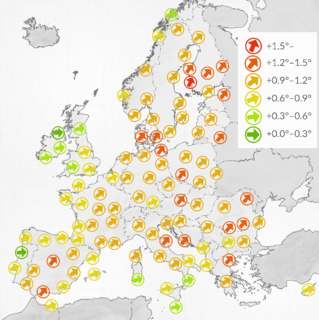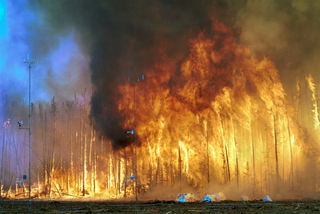
The greenhouse effect is a process that occurs when energy from a planet's host star goes through its atmosphere and heats the planet's surface, but greenhouse gases in the atmosphere prevent some of the heat from returning directly to space, resulting in a warmer planet. Earth's natural greenhouse effect keeps the planet from having the below freezing temperature that it would have if there were no greenhouse gases. Additionally, human-caused increases in greenhouse gases trap greater amounts of heat, causing the Earth to grow warmer over time.

Energy is sustainable if it "meets the needs of the present without compromising the ability of future generations to meet their own needs". Most definitions of sustainable energy include considerations of environmental aspects such as greenhouse gas emissions and social and economic aspects such as energy poverty. Renewable energy sources such as wind, hydroelectric power, solar, and geothermal energy are generally far more sustainable than fossil fuel sources. However, some renewable energy projects, such as the clearing of forests to produce biofuels, can cause severe environmental damage. The role of non-renewable energy sources in sustainable energy has been controversial. Nuclear power is a low-carbon source whose historic mortality rates are comparable to wind and solar, but its sustainability has been debated because of concerns about radioactive waste, nuclear proliferation, and accidents. Switching from coal to natural gas has environmental benefits, including a lower climate impact, but may lead to a delay in switching to more sustainable options. Carbon capture and storage can be built into power plants to remove their carbon dioxide emissions, but is expensive and has seldom been implemented.
Climate change mitigation generally refers to actions to limit climate change. The recent rise in global average temperature is mostly caused by greenhouse gases that are released released when fossil fuels are burned. The formal definition of climate change mitigation focuses on reducing greenhouse gas concentrations in the air, for example by transitioning to sustainable energy sources, conserving energy, and increasing efficiency. Further, CO2 can be removed from the atmosphere by enlarging forests and other natural and technical processes.

Carbon capture and storage (CCS) or carbon capture and sequestration is the process of capturing carbon dioxide (CO2) before it enters the atmosphere, transporting it, and storing it (carbon sequestration) for centuries or millennia. Usually the CO2 is captured from large point sources, such as a chemical plant or biomass power plant, and then stored in an underground geological formation. The aim is to prevent the release of CO2 from heavy industry with the intent of mitigating the effects of climate change. CO2 has been injected into geological formations for several decades for enhanced oil recovery and after separation from natural gas, but this has been criticised for producing more emissions when the gas or oil is burned.

In common usage, climate change describes global warming—the ongoing increase in global average temperature—and its effects on Earth's climate system. Climate change in a broader sense also includes previous long-term changes to Earth's climate. The current rise in global average temperature is more rapid than previous changes, and is primarily caused by humans burning fossil fuels. Fossil fuel use, deforestation, and some agricultural and industrial practices increase greenhouse gases, notably carbon dioxide and methane. Greenhouse gases absorb some of the heat that the Earth radiates after it warms from sunlight. Larger amounts of these gases trap more heat in Earth's lower atmosphere, causing global warming.

The Global Carbon Project (GCP) is an organisation that seeks to quantify global greenhouse gas emissions and their causes. Established in 2001, its projects include global budgets for three dominant greenhouse gases—carbon dioxide, methane, and nitrous oxide —and complementary efforts in urban, regional, cumulative, and negative emissions.

A global warming game, also known as a climate game or a climate change game, is a type of serious game. As a serious game, it attempts to simulate and explore real life issues to educate players through an interactive experience. The issues particular to a global warming video game are usually energy efficiency and the implementation of green technology as ways to reduce greenhouse gas emissions and thus counteract global warming. Global warming games include traditional board games, video games, and other varieties such as role-playing and simulation-assisted multiplayer games.

Arctic methane release is the release of methane from seas and soils in permafrost regions of the Arctic. While it is a long-term natural process, methane release is exacerbated by global warming. This results in a positive feedback cycle, as methane is itself a powerful greenhouse gas.

Carbon dioxide removal (CDR), also known as negative CO2 emissions, is a process in which carbon dioxide gas is removed from the atmosphere and sequestered for long periods of time. Similarly, greenhouse gas removal (GGR) or negative greenhouse gas emissions is the removal of greenhouse gases (GHGs) from the atmosphere by deliberate human activities, i.e., in addition to the removal that would occur via natural carbon cycle or atmospheric chemistry processes. In the context of net zero greenhouse gas emissions targets, CDR is increasingly integrated into climate policy, as a new element of mitigation strategies. CDR and GGR methods are also known as negative emissions technologies (NET), and may be cheaper than preventing some agricultural greenhouse gas emissions.

A zero-carbon city is a goal of city planners that can be variously defined. In a narrower sense of energy production and use, a zero-carbon city is one that generates as much or more carbon-free sustainable energy as it uses. In a broader sense of managing greenhouse gas emissions, a zero-carbon city is one that reduces its carbon footprint to a minimum by using renewable energy sources; reducing all types of carbon emissions through efficient urban design, technology use and lifestyle changes; and balancing any remaining emissions through carbon sequestration. Since the supply chains of a city stretch far beyond its borders, Princeton University's High Meadows Environmental Institute suggests using a transboundary definition of a net-zero carbon city as "one that has net-zero carbon infrastructure and food provisioning systems".
Bioenergy with carbon capture and storage (BECCS) is the process of extracting bioenergy from biomass and capturing and storing the carbon, thereby removing it from the atmosphere. The carbon in the biomass comes from the greenhouse gas carbon dioxide (CO2) which is extracted from the atmosphere by the biomass when it grows. Energy is extracted in useful forms (electricity, heat, biofuels, etc.) as the biomass is utilized through combustion, fermentation, pyrolysis or other conversion methods. Some of the carbon in the biomass is converted to CO2 or biochar which can then be stored by geologic sequestration or land application, respectively, enabling carbon dioxide removal (CDR) and making BECCS a negative emissions technology (NET).

Climate change feedbacks are important in the understanding of global warming because feedback processes amplify or diminish the effect of each climate forcing, and so play an important part in determining the climate sensitivity and future climate state. Feedback in general is the process in which changing one quantity changes a second quantity, and the change in the second quantity in turn changes the first. Positive feedback amplifies the change in the first quantity while negative feedback reduces it.

Climate change in Europe has resulted in an increase in temperature of 1.9 °C (2019) in Europe compared to pre-industrial levels. Europe's climate is getting warmer due to anthropogenic activity. According to international climate experts, global temperature rise should not exceed 2 °C to prevent the most dangerous consequences of climate change; without reduction in greenhouse gas emissions, this could happen before 2050. Climate change has implications for all regions of Europe, with the extent and nature of impacts varying across the continent.

Terrestrial ecosystems found in the boreal regions of North America and Eurasia cover less than 17% of the earth's land surface, yet contain more than 30% of all carbon present in the terrestrial biome. In terms of carbon storage, the boreal region consists of three ecosystems: boreal forest, peatland, and tundra. Vast areas of the globe and are contributing greatly to atmospheric carbon release due to increased temperature and fire hazard. High northern latitudes will experience the most significant increase in warming on the planet as a result of increased atmospheric greenhouse gases thus placing in jeopardy the carbon sink in these areas. In addition to the release of carbon through the melting of permafrost, high intensity wildfires will become more common and thus contribute to the release of stored carbon. This means that the boreal forest and its fire regime is becoming an increasingly more significant factor in determining the global carbon budget.

A carbon budget is "the maximum amount of cumulative net global anthropogenic carbon dioxide emissions that would result in limiting global warming to a given level with a given probability, taking into account the effect of other anthropogenic climate forcers". When expressed relative to the pre-industrial period it is referred to as the Total Carbon Budget, and when expressed from a recent specified date it is referred to as the Remaining Carbon Budget.
The transient climate response to cumulative emissions of carbon dioxide (TCRE) is the ratio of the globally averaged surface temperature change per unit carbon dioxide (CO2) emitted. As emitted CO2 may stay in the atmosphere for thousands of years, this response is the amount that the global temperature changes per the net amount of total carbon dioxide emitted by human activities into the atmosphere. Scientists agree that global temperature changes linearly regardless of the path taken to reach peak cumulative CO2 emissions. This means that for specific amount of cumulative CO2 emissions, a known global temperature change (within a range of uncertainty) can be expected, which indicates that holding global temperature change to below specific thresholds is a problem of limiting cumulative CO2 emissions, leading to the idea of a carbon budget.

Niklas Höhne is a German scientist in the field of national and international climate policy and mitigation of greenhouse gas emissions. He is founder of the NewClimate Institute in Cologne, Germany and professor at Wageningen University.

Climate change in India is having profound effects on India, which is ranked fourth among the list of countries most affected by climate change in 2015. India emits about 3 gigatonnes (Gt) CO2eq of greenhouse gases each year; about two and a half tons per person, which is less than the world average. The country emits 7% of global emissions, despite having 17% of the world population. Temperature rises on the Tibetan Plateau are causing Himalayan glaciers to retreat, threatening the flow rate of the Ganges, Brahmaputra, Yamuna and other major rivers. A 2007 World Wide Fund for Nature (WWF) report states that the Indus River may run dry for the same reason. Heat waves' frequency and intensity are increasing in India because of climate change. Severe landslides and floods are projected to become increasingly common in such states as Assam. Climate change performance index of India ranks eighth among 63 countries which account for 92% of all GHG emissions in the year 2021.
This article documents notable events, research findings, effects, and responses related to global warming and climate change during the year 2021.
Joeri Rogelj is a Belgian climate scientist working on solutions to climate change. He explores how societies can transform towards sustainable futures. He is a Reader in Climate Science and Policy at the Centre for Environmental Policy (CEP) and Director of Research at the Grantham Institute – Climate Change and Environment, both at Imperial College London. He is also affiliated with the International Institute for Applied Systems Analysis. He is an author of several climate reports by the Intergovernmental Panel on Climate Change (IPCC) and the United Nations Environment Programme (UNEP), and a member of the European Scientific Advisory Board for Climate Change.

















